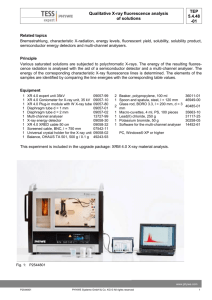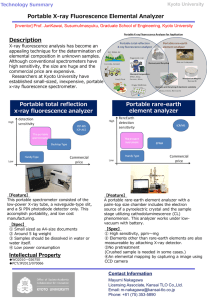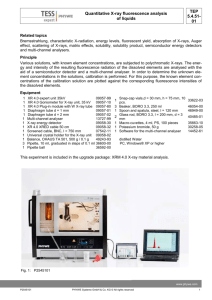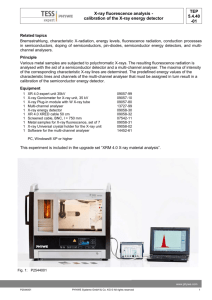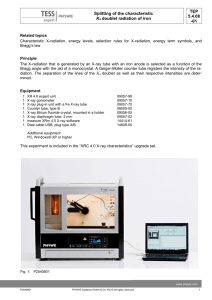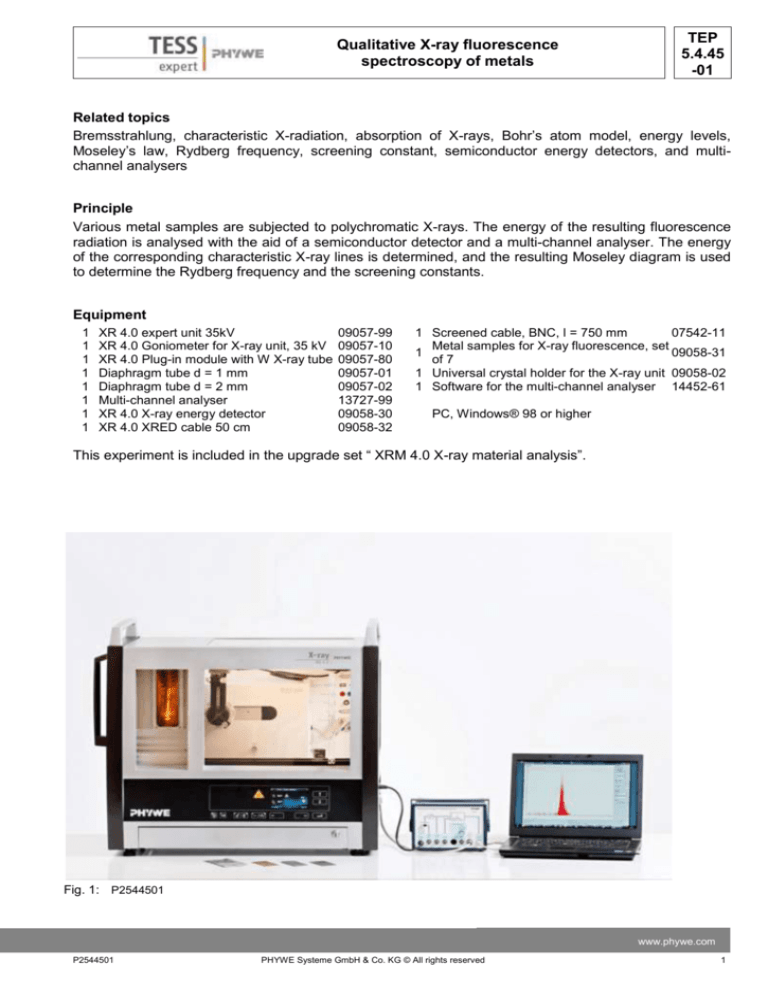
Qualitative X-ray fluorescence
spectroscopy of metals
TEP
5.4.45
-01
Related topics
Bremsstrahlung, characteristic X-radiation, absorption of X-rays, Bohr’s atom model, energy levels,
Moseley’s law, Rydberg frequency, screening constant, semiconductor energy detectors, and multichannel analysers
Principle
Various metal samples are subjected to polychromatic X-rays. The energy of the resulting fluorescence
radiation is analysed with the aid of a semiconductor detector and a multi-channel analyser. The energy
of the corresponding characteristic X-ray lines is determined, and the resulting Moseley diagram is used
to determine the Rydberg frequency and the screening constants.
Equipment
1
1
1
1
1
1
1
1
XR 4.0 expert unit 35kV
XR 4.0 Goniometer for X-ray unit, 35 kV
XR 4.0 Plug-in module with W X-ray tube
Diaphragm tube d = 1 mm
Diaphragm tube d = 2 mm
Multi-channel analyser
XR 4.0 X-ray energy detector
XR 4.0 XRED cable 50 cm
09057-99
09057-10
09057-80
09057-01
09057-02
13727-99
09058-30
09058-32
1 Screened cable, BNC, l = 750 mm
07542-11
Metal samples for X-ray fluorescence, set
1
09058-31
of 7
1 Universal crystal holder for the X-ray unit 09058-02
1 Software for the multi-channel analyser 14452-61
PC, Windows® 98 or higher
This experiment is included in the upgrade set “ XRM 4.0 X-ray material analysis”.
Fig. 1: P2544501
www.phywe.com
P2544501
PHYWE Systeme GmbH & Co. KG © All rights reserved
1
TEP
5.4.45
-01
Qualitative X-ray fluorescence
spectroscopy of metals
Tasks
1. Calibrate the semiconductor energy detector
with the aid of the characteristic radiation of the
tungsten X-ray tube.
2. Record the spectra of the fluorescence radiation
that are generated by the metal samples.
3. Determine the energy values of the corresponding characteristic Kα- and Kβ-lines.
4. Determine the Rydberg frequency and screening
constants with the aid of the resulting Moseley
diagrams.
Set-up and procedure
Set-up (Fig. 1)
Screw the adapter ring onto the inlet tube of the
energy detector.
Fig. 2: Connections in the experimentation area
Connect the signal and supply cables to the
corresponding ports of the detector with the aid
of the right-angle plugs.
Connect the signal and supply cables from the
MCA to the appropriate connections in the experiment chamber of the X-ray unit (signal cable: red, supply cable: green (see Fig. 2)).
Connect the external ports for the X RED of the
x-ray unit (signal cable red, supply cable green,
see Fig. 3) to the multi-channel analyse (MCA). Fig. 3: Connection at the external panel of the XR 4.0 Xray expert unit to the MCA
Connect the signal cable via a screened BNCcable to the “Input” port of the MCA and the
supply cable to the “X-Ray Energy Det.” port of
X-ray energy
the MCA.
detector
Secure the energy detector in the holder of the
swivel arm of the goniometer (Fig 4). Lay the
two cables with sufficient length so that the goniometer can be swivelled freely over the entire
swivelling range.
Connect the multi-channel analyser and computer with the aid of the USB cable.
Insert the tube with the 2-mm-aperture.
Bring the goniometer block and the detector to
Left position of the
their respective end positions on the left. Bring
goniometer
the detector to the 90° position in the 2:1 couUniversal crystal
pling mode (Fig. 4).
holder with metal
sample
Procedure
Calibration of the multi-channel analyser
(if there is no other already existing calibration that
can be used)
Bring the goniometer block and the detector to
Fig. 4: Set-up at the goniometer
2
PHYWE Systeme GmbH & Co. KG © All rights reserved
P2544501
Qualitative X-ray fluorescence
spectroscopy of metals
-
-
-
-
-
-
TEP
5.4.45
-01
their respective end positions on the right.
Insert the tube with the 1-mm-aperture into the
exit tube of the X-ray tube.
With the X-ray unit switched on and the door
locked, bring the detector to the 0° position.
Then, shift the detector by some tenths degree
out of the zero position in order to reduce the
total rate.
Operating data of the tungsten X-ray tube: Select an anode voltage UA = 25 kV and an anode current IA = 0.02 mA.
Switch on the X-radiation
Fig. 5: Calibration of the Multi-channel analyser.
In the MEASURE program, select “Multi channel analyser” under “Gauge”. Then, select
“Settings and calibration”. After the “Calibrate” button has been clicked, a spectrum can be measured. The counting rate should be < 300 c/s. Energy calibration settings: - 2-point calibration, - Unit
= keV, Gain = 2 – Set the offset so that low-energy noise signals will be suppressed (usually a few
per cent are sufficient), See Fig 5.
Measuring time: 5 minutes. Use the timer of the X-ray unit.
Make the two coloured calibration lines congruent with the line centres of the two characteristic Xray lines. The corresponding energy values (see e.g. P2544701) E(L3M5/L3M4) = 8,41 keV and
E(L2N4) = 9,69 keV are entered into the corresponding fields, depending on the colour. (Note: Since
a separation of the lines L3M5 and L3M4 Lines is not possible, the mean value of both lines is entered as the energy of the line).
Name and save the calibration.
Task 2: Spectrum recording
Insert the tube with the 2-mm-aperture.
Bring the goniometer block and the detector to their respective end positions on the left. Bring the
detector to the 90° position in the 2:1 coupling mode.
Insert the metal sample with the universal crystal holder (sample at 45°).
Operating data of the molybdenum X-ray tube: Adjust an anode voltage Ua = 35 kV and an anode
current so that the counting rate is ≤ 300 c/s.
Measuring time: 3 minutes (use the timer of the X-ray unit).
Task 3: Evaluation of the measurement curves
In order to determine the line energy, switch from the bar display to the curve display. To do so, click
“Display options” and then “Interpolation and straight lines”.
Extend the relevant line section with the aid of the zoom function
.
-
-
Then, select the curve section with . Open the window “Function fitting” . Then, select “Scaled
normal distribution” and confirm.
Find the line centroid of the normal distribution with “Peak analysis”
or determine it with the function “Survey”
.
Theory and evaluation
When X-rays interact with matter, they lose energy due to Compton scattering, pair production, and photoelectric effects. In the range of energy that is available during this experiment, the photoelectric effect
plays the most important role. This means that in the atom on one of the lower shells an electron is
ejected due to the absorbed photon energy.
www.phywe.com
P2544501
PHYWE Systeme GmbH & Co. KG © All rights reserved
3
TEP
5.4.45
-01
Qualitative X-ray fluorescence
spectroscopy of metals
The now free space is taken by an electron from one of the higher shells. The energy that is produced
during this process can be used for the ejection of another electron from one of the higher shells (Auger
effect) or for the generation of a photon (fluorescence radiation). In a first approximation, the uninvolved
electrons are regarded as fixed during these processes. Their influence is taken into consideration by the
introduction of a so-called screening constant σ, which reduces the effect of the nuclear charge.
If relativistic and spin-orbit coupling effects are neglected, the binding energy En of an electron on the nth
shell of an atom can be described in an approximate manner by Bohr's atom model:
En
mee 4
Z 2 12
2 2
8 0 h
n
Electron mass
Elementary charge
Planck’s constant
Permittivity
Atomic number
Screening constant
Prinicipal quantum number
me
e
h
e
Z
σ
n
=
=
=
=
(1)
9.109∙10-31 kg
1.602∙10-19 C
6.626∙10-34 Js
8.854∙10-12 N-1m-2C2
With the introduction of the Rydberg frequency
R
mee4
3.29 1015 s 1
2 3
8 0 h
(1) leads to
En R hZ
2
1
n2
(2)
The screening constant depends on the location of the excited electron and on the configuration of the
other electrons.
Due to the migration of an electron from n2 to n1 (n2 > n1) and in accordance with (1), the energy of the released radiation is:
Z n1 2 Z n 2 2
E R h
n12
n22
(3)
Instead of two screening constants for the migration from n2 to n1, a mean screening constant σ2,1 is introduced. As a result, (3) is simplified to:
1
2 1
E R hZ 2,1 2 2
n1 n2
(4)
If √E is plotted as a function of Z, the so-called Moseley diagram results. With n2 = 2 and n1 =1 (characteristic Kα-line), (4) leads to:
4
PHYWE Systeme GmbH & Co. KG © All rights reserved
P2544501
TEP
5.4.45
-01
Qualitative X-ray fluorescence
spectroscopy of metals
E
3
3
Rh Z
Rh 2,1
2
2
(5)
Correspondingly, the following applies from the migration from n3 to n1 with a mean screening constant
σ3,1 (characteristic Kβ-line):
E
8
8
Rh Z
Rh 3,1
3
3
(6)
Figure 6 shows the fluorescence spectra of various metals (the Mo-spectrum was obtained as a control
point through the analysis of the primary radiation of the Mo X-ray tube and, therefore, does not come
from a metal sample).
Task 2: Record the spectra of the fluorescence radiation that are generated by the metal samples.
Fig. 6 shows the fluorescence spectra of different metals.
Task 3: Determine the energy values of the corresponding characteristic Kα- and Kβ-lines.
The results of the spectra evaluation are listed in the table. The columns C and D include the energy
values of the characteristic Kα- and Kβ-lines that were obtained from the spectra that are shown in Figure
6. For comparison, the columns E and F show the corresponding literature, with the mean value of the
Kα1 - and Kα2-lines as the energy of the Kα-line.
Table
A
B
Z
C
E(Kα) exp. / keV
D
E(Kβ) exp. / keV
E
E(Kα) lit. / keV
F
E(Kβ) lit. / keV
element
Fe
Ni
Cu
Zn
Mo*
Ag
Sn
26
28
29
30
42
47
50
6,39
7,47
8,04
8,63
17,38
22,07
25,15
7,03
8,26
8,90
9,57
19,56
24,91
28,46
6,397
7,474
8,039
8,627
17,427
22,076
7,056
8,265
8,905
9,572
19,608
24,942
* The Mo spectrum was obtained through the analysis of the primary radiation of the Mo X-ray tube and is not
caused, therefore, by any of the metal samples
www.phywe.com
P2544501
PHYWE Systeme GmbH & Co. KG © All rights reserved
5
TEP
5.4.45
-01
Qualitative X-ray fluorescence
spectroscopy of metals
Zn
Fe
Cu
Ni
Ag
Sn
Fig. 6: Fluorescence spectra of various metals
6
PHYWE Systeme GmbH & Co. KG © All rights reserved
P2544501
TEP
5.4.45
-01
Qualitative X-ray fluorescence
spectroscopy of metals
Task 4: Determine the Rydberg frequency and screening constants with the aid of the resulting Moseley
diagrams.
Figure 7 shows the Moseley lines for the characteristic Kα and Kβ lines. R can be calculated with the gradients of the regression lines that were added.
The gradient of the regression line of the Kα-lines is defined as follows:
𝑚=
√3 ∙ 𝑅 ∙ ℎ
2
Transformation gives:
𝑚2 =
3∙𝑅∙ℎ
4
Enter the value for the slope of the Kα Moseley line and transfer keV to J. Thus:
3∙𝑅∙ℎ
= 0,0106𝑘𝑒𝑉 = 1,698 ∙ 10−18 𝐽
4
and R = 3,41∙1015s-1
The gradient of the regression line of the Kβ-line gives:
8∙𝑅∙ℎ
= 0.0123𝑘𝑒𝑉 = 1.974 ∙ 10−18 𝐽
9
R = 3,35∙1015s-1
With Z = 0 and Rh = 13.6 eV, the intercepts of the
corresponding Moseley lines lead to: σ2,1 ≈ 1.5 and
σ3,1 ≈ 2.2.
The values of the screening constants that were determined with the aid of Bohr’s atom model have only limited validity, since more detailed calculations
(Hartree) show that the radial charge density distribution of some electrons, e.g. of the 3p electron,
have a secondary maximum near the nucleus. It is
nevertheless plausible that σ2,1 > 1 and σ3,1 > σ2,1,
since during the Kα process, the remaining 1s electron and in addition also the uninvolved 2s electrons
screen the nuclear charge, whereas during the Kβ
transition all of the electrons of the L level have an
additional screening effect.
√𝐸√𝑘𝑒𝑉
Kβ-line y = 0.111x + 0,229
Kα-line y = 0.103x + 0,140
Z
Abb. 7: Moseley lines of the Kα- and Kβ-lines
www.phywe.com
P2544501
PHYWE Systeme GmbH & Co. KG © All rights reserved
7
TEP
5.4.45
-01
8
Qualitative X-ray fluorescence
spectroscopy of metals
PHYWE Systeme GmbH & Co. KG © All rights reserved
P2544501


